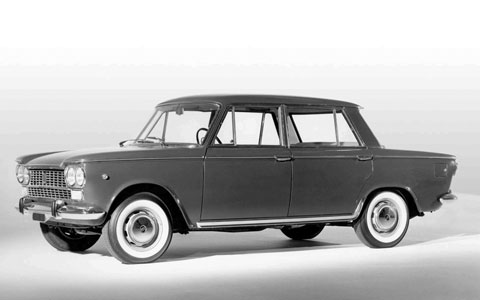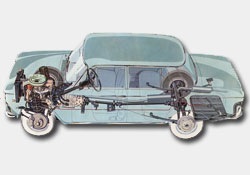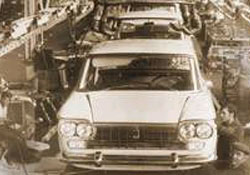
All-around disc brakes. Rear-wheel-drive. Up to 72 horsepower. The Zastava 1300 (tristać) was destined to become Yugoslavia's favorite upmarket car
Zastava's annual production climbed to 13,719 units in 1960. The company entered the new decade with a replacement for the 1400: Fiat's 1100, shown in Geneva as the successor to the 1100 B.
Designed by Bertone, the 1100 would be produced by Fiat; Zastava; Germany's NSU Fiat, and by Austria's Steyr Fiat. It packed 36 horsepower through 1955; 40 until 1957 and, finally, 43 through its end in 1966.
With the advent of the 1961 Fiat 1300 and 1500 came Zastava's 1300/ 1500 series, produced as both sedans and wagons.
With all-around disc brakes; rear-wheel-drive, and up to 72 horsepower, the elegant
tristać was Yugoslavia's favorite upmarket car.
Today, many across the former Yugoslavia recall the 1300 as Zastava's best automobile ever: the
Jugoslovenski Mercedes, they call it. 201,160 copies of the 1300 and 1500 were produced from 1961 through December 20
th, 1979.
The Zastava 1300 and 1500:
"Jugoslovenski Mercedes" (more) 

Length: 4,030 mm. Width: 1,545 mm. Height: 1,365 mm. Wheelbase: 2,425 mm. Curb weight: 960 kg. The heart of the Zastava 1500 was transplanted to create the Zastava 125PZ (below)

Drawing obvious inspiration from America's Chevrolet Corvair, the 1300
(milletrecciento, in Italy) and 1500
(millecinquecento) were Zastava's family cars for the '60s and '70s.
Both used longitudinally-installed engines powering the rear axle via a four-speed manual transmission.
The engines employed - 1,295cc and 1,481cc - were two versions of the same overhead-valve design, differing in bore (72 mm and 77 mm, respectively).
The 1300 produced 65 brake horsepower (@ 5,200 rpm); the 1500, 72 brake horsepower (@ 5,200 rpm).
The larger engine could propel the car to a top speed of 155 km/h.
In the '70s, Zastava raised the equipment levels and added
DeLuxe and
1300E models.
The floorpan of the 1300/ 1500 was used as the basis for the Polski-Fiat 125p, which was produced by Polish FSO from Zastava CKD kits.
The 125p was created by mating the body of the Fiat 125 to the mechanicals (engines; gearbox; transmission, and suspension) of the 1300 and 1500.
On the Yugoslav market, the 125p was known as the Zastava 125PZ.
Longer than the Zastava 1500, its wheelbase extended by 80 millimeters, the 970kg 125PZ shared the 1500's 155 km/h top speed.

Production capacity was expanded to 85,000 by the end of the '60s
1965 marked the official beginning of Zastava exports, with 6,000 cars sent to Poland.
In 1967, Zastava produced about 52,000 trucks and passenger cars; in 1968, 53,000.
Zastava signed a new contract expanding production and technological cooperation with Fiat. A $10 million investment expanded capacity to 85,000, with plans in place to reach 130,000 units within a five-year period.
In 1969, the
Zastava Kamioni (Zastava Trucks) division split from Zastava Automobili, and began producing Italy's Om trucks, rated for between 2.5 and 4 tons.
Today, Zastava Kamioni (
www.zastava-kamioni.co.yu) continues to make trucks through a partnership with Iveco.